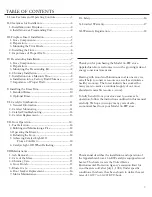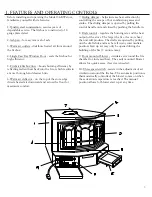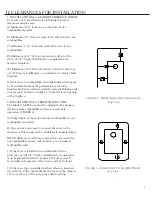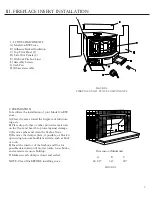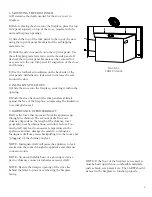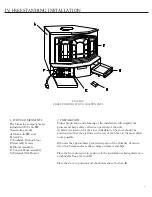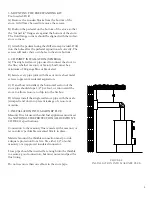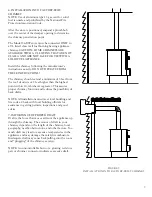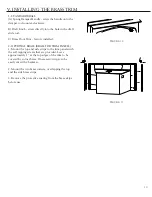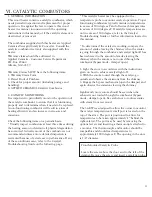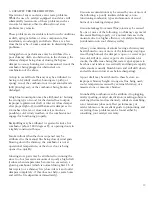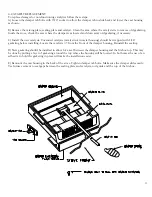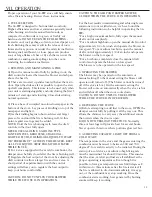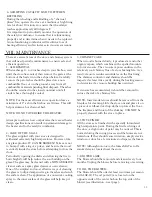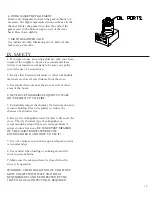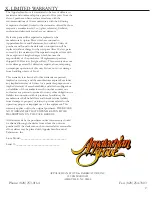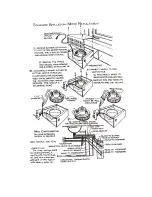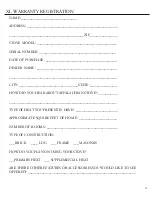
12
3. CATALYST TROUBLESHOOTING
Operation of any wood stove can create problems.
While the use of a catalyst equipped wood stove will
substantially lessen some of these problems, such as
creosote formation, other traditional wood stove
problems may remain.
These problems are invariable related to such conditions
as draft, aging or failure of stove components, flue
installation, wood supply and others. Here are a few
clues that may be of some assistance in discerning these
problems:
A sluggish stove performance may be attributed to: a
poor chimney draft; an obstruction in the chimney; the
chimney damper being closed; closing the bypass
damper too soon; burning wet or unseasoned wood; the
combustor being plugged or obstructed; or a
combination of the above.
A drop in overall fuel efficiency may be attributed to:
having cold, windy weather, burning wet, pithy, or
spongy wood; the combustor not in operational mode
(600 plus degrees); or the combustor being broken or
dislodged.
A high fuel consumption may be attributed to: burning
the wrong type of wood for the desired heat output;
improper regulation of draft or inlet air (close damper
after proper light off, install barometric damper set to
.06 inches of water, or close inlet air as much as
possible); cold, windy weather; or the combustor not
engaged or functioning properly.
Backpuffing may be attibuted to: gusts of wind; a hot
combustor (above 1400 degrees F); or opening doors in
a tightly constructed house.
Smoke rollout when the door is opened may be
attributed to: the manual flue being closed; wind gusts
blowing down the chimney; the combustor is not at
operational temperature; or the stove door is being
opened too quickly.
Glowing stove parts may be attributed to: running the
stove too hot (excessive amounts of wood); a high draft
(reduce when temperatures become too excessive); a
glowing combustor (which is normal during first 1/3 of
burn cycle); or a chimney fire (close inlet air and outlet
dampers completely - if this does not help, vacate home
and call the fire department immediately).
Creosote accumulation may be caused by one or more of
the following: a poorly insulated chimney; a non-
functioning combustor; types and amounts of wood
burned; or a leaking damper plate.
Creosote leakage from metal flue joints may be caused
by one or more of the following: no chimney cap; metal
flue assembled improperly; or a normal increase in the
moisture due to a higher efficiency of catalytic burning
(condensation on cool chimney walls).
A heavy concentration of smoke leaving a chimney may
be attributed to one or more of the following: improper
wood being burned; the damper is open; or water vapor
(on cold, still days, water vapor is often mistaken for
smoke, the difference being that water vapor appears to
be white and tends to rise vertically and dissipate rapidly
while smoke is usually bluish brown and will drift down
and settle down in low areas before dissipating).
A poor draft may be attributed to these factors: an
improper chimney height; wrong size flue being used;
cooler temperatures caused by external chimney; or a
massive stone or masonry chimney.
An unhealthy combustor can be attributed to plugging,
catalyst peeling, catalyst deactivation, masking, substrate
cracking (thermal and mechanical), substrate crumbling,
color variations (does not affect performance), or
catalyst abrasion. An excellent guide to pinpointing and
correcting these problems can be found either by
consulting your catalyst warranty.
Summary of Contents for 36-BW
Page 18: ......


